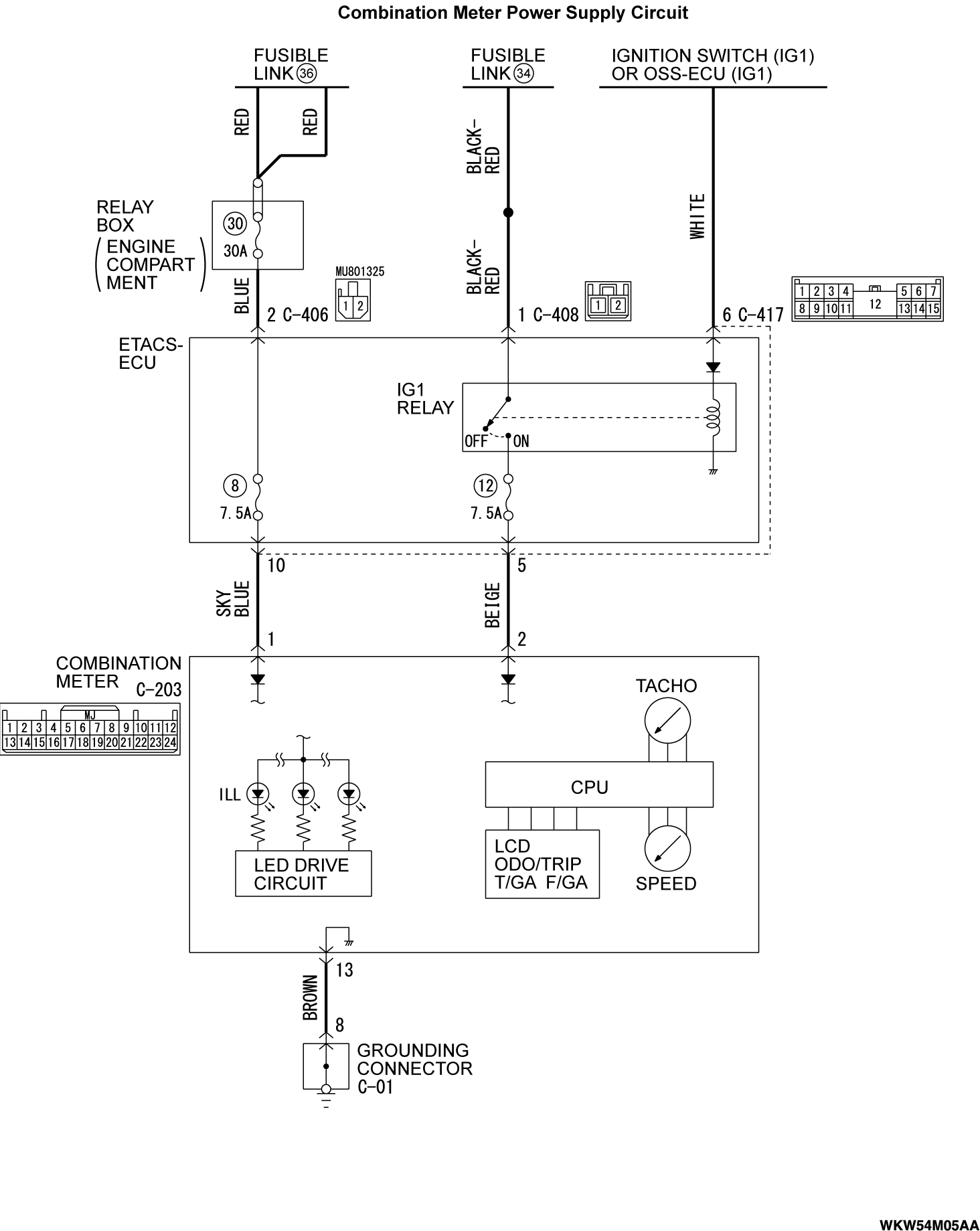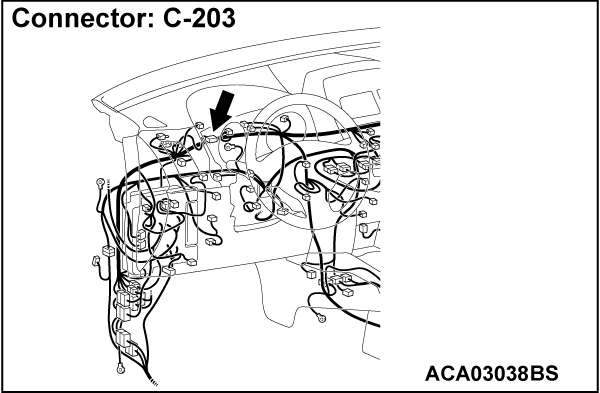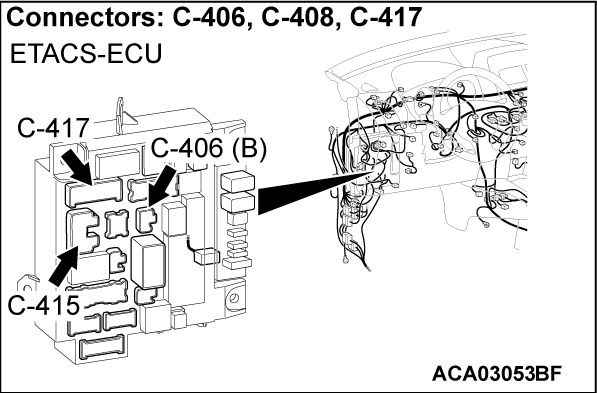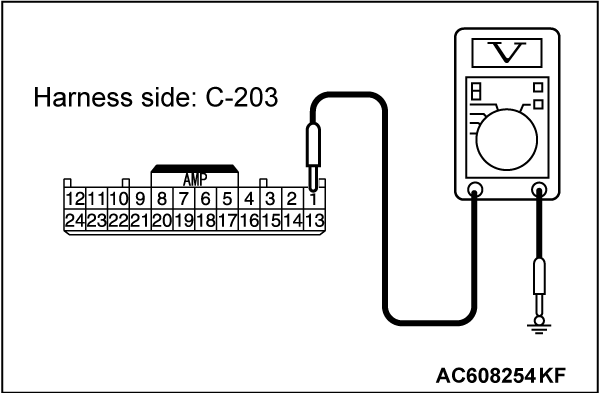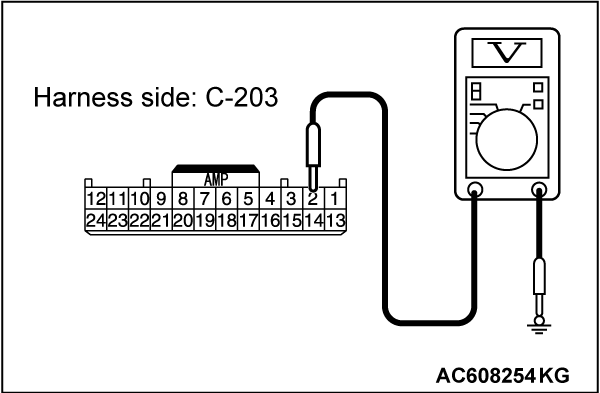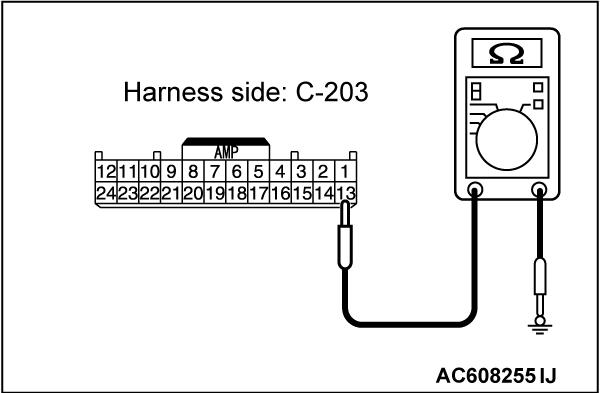Inspection Procedure 1: Power supply circuit check.
TECHNICAL DESCRIPTION (COMMENT)
If the odometer and tripmeter do not display or no needle meters work, the power supply to the combination meter, or the combination meter itself may have a problem.
TROUBLESHOOTING HINTS
- The wiring harness or connectors may have loose, corroded, or damaged terminals, or terminals pushed back in the connector
- The combination meter may be defective
DIAGNOSIS
Required Special Tools:
- MB991223: Harness Set
- MB992006: Extra Fine Probe
STEP 1. Using scan tool MB991958, read the combination meter diagnostic trouble code.
Check if DTC is set in the combination meter.
(1)
| caution | To prevent damage to scan tool MB991958, always turn the ignition switch to the "LOCK" (OFF) position before connecting or disconnecting scan tool MB991958. |
(2) Turn the ignition switch from "LOCK" (OFF) position to "ON" position.
(3) Check if DTC is set.
(4) Turn the ignition switch to the "LOCK" (OFF) position.
Is the DTC set?
STEP 2. Check combination meter connector C-203 for loose, corroded or damaged terminals, or terminals pushed back in the connector.
STEP 3. Check the battery power supply circuit to the combination meter. Measure the voltage at combination meter connector C-203.
(1) Disconnect the connector, and measure at the wiring harness side.
(2) Turn the ignition switch to the LOCK (OFF) position.
(3) Measure the voltage between terminal 1 and ground.
- The voltage should measure approximately 12 volts (battery positive voltage).
Is the measured voltage approximately 12 volts (battery positive voltage)?
STEP 4. Check the wiring harness between combination meter connector C-203 (terminal 1) and the fusible link (36).
- Check the power supply line (battery supply) for open circuit and short circuit.
Is the wiring harness between combination meter connector C-203 (terminal 1) and the fusible link (36) in good condition?
 The trouble can be an intermittent malfunction (Refer to GROUP 00 - How to Cope with Intermittent Malfunction
The trouble can be an intermittent malfunction (Refer to GROUP 00 - How to Cope with Intermittent Malfunction  ).
). Repair the wiring harness.
Repair the wiring harness.STEP 5. Check the battery power supply circuit to the combination meter. Measure the voltage at combination meter connector C-203.
(1) Disconnect the connector, and measure at the wiring harness side.
(2) Turn the ignition switch to the ON position.
(3) Measure the voltage between terminal 2 and ground.
- The voltage should measure approximately 12 volts (battery positive voltage).
Is the measured voltage approximately 12 volts (battery positive voltage)?
STEP 6. Using scan tool MB991958, check data list.
Check the input signal from the ignition switch (IG1) in the ETACS-ECU.
(1) Check the ETACS data list.
- Turn the ignition switch to the "ON" position.
|
(2) Turn the ignition switch to the "LOCK" (OFF) position.
Do the scan tool MB991958 display the item "IG voltage" is normal condition?
STEP 7. Check the wiring harness between combination meter connector C-203 (terminal 2) and the fusible link (34).
- Check the power supply line (battery supply) for open circuit and short circuit.
Is the wiring harness between combination meter connector C-203 (terminal 2) and the fusible link (34) in good condition?
 The trouble can be an intermittent malfunction (Refer to GROUP 00 - How to use Troubleshooting/inspection Service Points - How to Cope with Intermittent Malfunction
The trouble can be an intermittent malfunction (Refer to GROUP 00 - How to use Troubleshooting/inspection Service Points - How to Cope with Intermittent Malfunction  ).
). Repair the wiring harness.
Repair the wiring harness.STEP 8. Check the ground circuit to the combination meter. Test at combination meter connector C-203.
(1) Disconnect the connector, and measure at the wiring harness side.
(2) Measure the resistance value between terminal 13 and ground.
- The resistance should be 2 ohms or less.
Is the measured resistance 2 ohms or less?
STEP 9. Check the wiring harness between combination meter connector C-203 (terminal 13) and ground.
- Check the ground wire for open circuit.
Is the wiring harness between combination meter connector C-203 (terminal 13) and ground in good condition?
 The trouble can be an intermittent malfunction (Refer to GROUP 00 - How to use Troubleshooting/inspection Service Points - How to Cope with Intermittent Malfunction
The trouble can be an intermittent malfunction (Refer to GROUP 00 - How to use Troubleshooting/inspection Service Points - How to Cope with Intermittent Malfunction  ).
). Repair the wiring harness.
Repair the wiring harness.STEP 10. Retest the system.
Check that the combination meter works normally. The trouble can be an intermittent malfunction (Refer to GROUP 00 - How to use Troubleshooting/inspection Service Points - How to Cope with Intermittent Malfunction
The trouble can be an intermittent malfunction (Refer to GROUP 00 - How to use Troubleshooting/inspection Service Points - How to Cope with Intermittent Malfunction  ).
). Replace the combination meter.
Replace the combination meter.
Is the check result satisfactory?
 The trouble can be an intermittent malfunction (Refer to GROUP 00 - How to use Troubleshooting/inspection Service Points - How to Cope with Intermittent Malfunction
The trouble can be an intermittent malfunction (Refer to GROUP 00 - How to use Troubleshooting/inspection Service Points - How to Cope with Intermittent Malfunction  ).
). Replace the combination meter.
Replace the combination meter.![[Previous]](../../../buttons/fprev.png)
![[Next]](../../../buttons/fnext.png)
